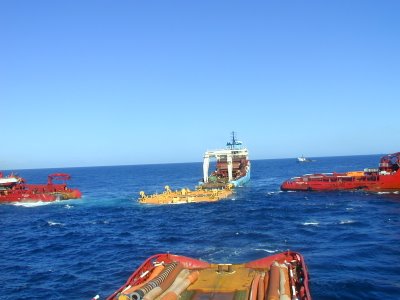 Picture 1
Picture 1
Picture 2
VESSEL:
NAME FAR CENTURION
COMPANY FARSTAD SHIPPING
TYPE AHTS
CALL SIGN GDDP
FLAG ISLE OF MAN
REGISTRY PORT DOUGLAS
MODEL ME 303
BUILDING YEAR 1983
CLASS FI-FI II
L.O.A. 68.00 M
GROSS TONNAGE 1971 T
DEADWEIGHT 2056 T
DISPLACEMENT 4277 T
MAIN ENGINES 04 X 3260 BHP……….13040 BHP
BOW THRUSTER 02 X LIPS 800 BHP…..1600 BHP
STERN THRUSTER 01 X LIPS 800 BHP……800 BHP
BOLLARD PULL 141 T CONTINUOUS
Operation:
Submersible Riser Holding Buoy Trial
Trial purpose was to sink the buoy at 100m in a water deep of 500m with a weight of 50 ton, this weight was located in the centre of the square buoy attached to each corner by some type of kite bridle, the buoy was designed to be anchored with four “torpedo” anchors in each corner.
As soon as the buoy moored and stabilise at 100m deep, the risers should be picked up from the bottom by a DP Line Ship and put it in the buoy holding “Risers supports”.
Vessel task:
Towing, mooring and sink the buoy in her location.
Buoy displacement (Full ballast) 700 ton.
Tow length 400 m
Tow wire diameter 75 mm
The vessel Far Centurion started all operation towing the buoy from “Sermetal” shipyard in Rio de Janeiro to “Barracuda” Oil Field at Campos Basin in Brazil.
The manoeuvre of taking out the buoy from shipyard took some time, mainly because we stood waiting to fill up the dry dock where was the buoy, and tow wire final connection to the buoy bridle became quite difficult, but didn’t put to much trouble on the handling side due the vessel easy manoeuvrability see Picture 3

Picture 3
With Pilot on board we start steaming down the fairway direction out in to the sea.
The tow to “Macae” port (Charter Base) took one day.
During the standby in “Macae” roads we were dodging two miles out of anchorage, awaiting for pre-launching anchors operation at the field.
After one week on this status we received instructions to proceed to “Barracuda“ Oil Field, one day steaming and we arrived on location where the others vessels were awaiting for us.
The others vessels involved were Far Santana (220ton bollard pull), Far Sailor (190ton bollard pull), Maersk Boulder (220ton bollard pull), this all are AHTS(Anchor Handling Tug Ship), and a small DP vessel for ROV purposes.
First thing to do was locate the buoy over her position in the way that the other vessels could connect the anchors chains to the buoy mooring chains bit, making a strait square (the buoy has one mooring chain in each corner) Picture 4.
 Picture 4
Picture 4Far Centurion “my” vessel stood holding the buoy in position and the others vessels started to do anchors connections jobs, this all operation had involved also the Far Centurion work boat (PVC jet propulsion kind of FRC) to transfer the workers and divers to the Buoy to help on the chains connection.
One day was needed, to pick up from the bottom and connect all chains, with the help of the ROV boat to locate the chains on the sea bed.
Some small problems were found on the design related with chain pipes and chain stoppers, the process to sink the buoy had rise a lot of doubts in all the vessels Masters involved in the operation also.
When everything was ready to start the buoy sinking operation the ROV started to check all underwater mooring systems connections and found one quick release hook (Pelican Hook) opened.
Unfortunately this problem couldn’t be solved easily and the Charter instructed all involved to resume operations and I as Far Centurion Master instructed to tow the buoy back to the shipyard in Rio de Janeiro.
See you next time, best nautical regards Captain Jose Saraiva (Far Centurion Master)
PS: I have reduced description of operation process where I thought appropriated and charter name preserved.
POSTED BY JOSÉ SARAIVA
No comments:
Post a Comment